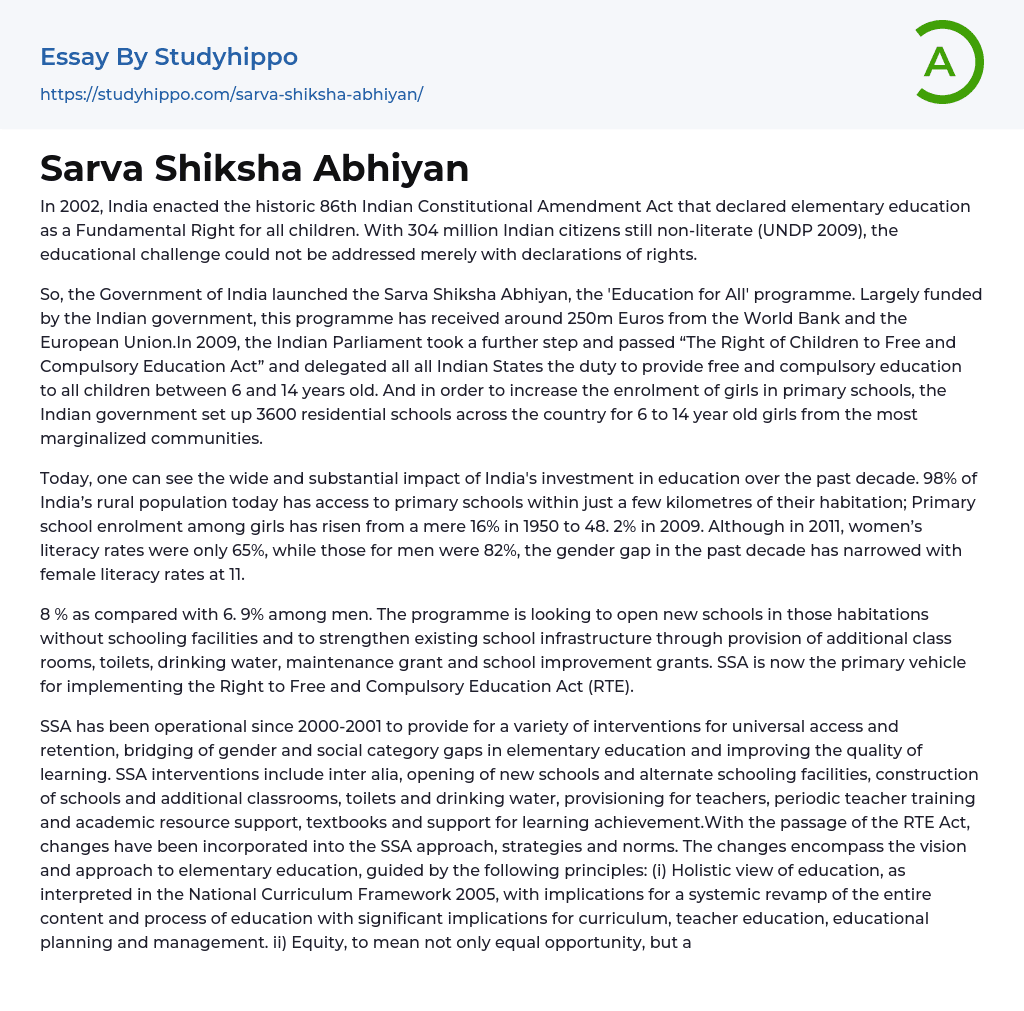The 86th Indian Constitutional Amendment Act of 2002 was a significant milestone as it acknowledged elementary education as a Fundamental Right for every child in India. However, despite this accomplishment, the country still confronts the daunting fact that UNDP (2009) reports 304 million individuals cannot read or write, indicating that recognizing rights alone will not solve the education problem.
The Indian government has initiated Sarva Shiksha Abhiyan, known as the 'Education for All' program, which is largely financed by India. In addition, it has received approximately 250m Euros from both the European Union and World Bank. The Right of Children to Free and Compulsory Education Act was enacted in 2009 obligating free education for children aged between 6-14 years old throughout all states of India. Furthermore, the government created 3600 boarding schools across the country to enro
...ll underprivileged girls aged between 6-14 years old, thus enhancing their involvement in primary education.
In the past ten years, India has made noteworthy strides in education investment. Almost all (98%) of rural residents now have primary schools nearby. Additionally, girls' enrolment in primary schools has risen from 16% in 1950 to 48.2% as of 2009. While women's literacy rates were at only 65% compared to men's rate of 82% in 2011, progress has been made over the last decade with female literacy rates increasing.
The purpose of the SSA initiative is to enhance education in underprivileged regions by constructing new schools and improving existing ones with more classrooms, restrooms, and drinking water. Additionally, it offers financial support for school maintenance as well as improvement grants. The program's primary objective is to enforce the Right to Free and Compulsory Education Act (RTE)
due to an 8% dropout rate among females and a 6.9% dropout rate among males.
The SSA has been operational since 2000-2001 and aims to achieve universal access and retention in primary education while bridging gender and social category gaps. The program focuses on enhancing the quality of learning through various interventions, such as opening new schools, constructing classrooms and facilities, providing toilets and drinking water, ensuring an adequate number of teachers, offering regular teacher training and academic resources, as well as textbooks and support for learning achievement. With the implementation of the RTE Act, the SSA approach has undergone changes that reflect a holistic view of education based on the National Curriculum Framework 2005. This revised vision prioritizes equity not only as equal opportunity but also seeks to create favorable conditions that positively impact disadvantaged children from SC, ST, Muslim minority backgrounds, landless agricultural workers, and those with special needs.
The opportunity can be taken advantage of by (iii) offering accessibility, which does not solely involve guaranteeing that a school is reachable for all children within a specified proximity, but also involves recognizing the academic necessities and dilemmas encountered by the SC, ST, and other sections of the most underprivileged groups, the Muslim minority, girls in general, and children requiring special assistance. (iv) Consideration for gender, which involves not only striving to empower girls to keep pace with boys, but also acknowledging education from the perspective outlined in the National Policy on Education 1986/92, namely a definite move towards bringing about a fundamental change in the position of women.
(v) It is essential to prioritize the role of the teacher in fostering innovation and cultivating
a classroom and community culture that is inclusive for girls from oppressed and marginalized backgrounds. (vi) The RTE Act places a moral obligation on parents, teachers, educational administrators, and other stakeholders, emphasizing the importance of cooperation rather than punishment. (vii) A unified and integrated educational management system is necessary for implementing the RTE law, and all states should work toward this goal as quickly as possible.
- Academia essays
- Higher Education essays
- Language Learning essays
- Studying Business essays
- Education System essays
- Study essays
- First Day of School essays
- Scholarship essays
- Pedagogy essays
- Curriculum essays
- Coursework essays
- Studying Abroad essays
- Philosophy of Education essays
- Purpose of Education essays
- Brainstorming essays
- Educational Goals essays
- Importance Of College Education essays
- Brown V Board of Education essays
- The Importance Of Higher Education essays
- Online Education Vs Traditional Education essays
- Academic And Career Goals essays
- Academic Integrity essays
- Brown Vs Board Of Education essays
- Distance learning essays
- Technology in Education essays
- Vocabulary essays
- Writing Experience essays
- Importance of Education essays
- Early Childhood Education essays
- Academic Degree essays
- Academic Dishonesty essays
- School Uniform essays
- Academic writing essays
- Cheating essays
- Bachelor's Degree essays
- MBA essays
- College Life essays
- Grade essays
- Diploma essays
- Phonology essays
- Sentence essays
- Filipino Language essays
- Pragmatics essays
- Millennium Development Goals essays
- History Of Education essays
- Graduate School essays
- Middle School essays
- School essays
- Special Education essays
- University essays




